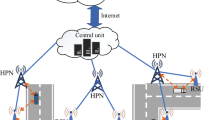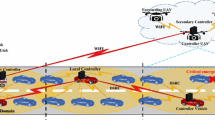Abstract
With recent advances in wireless communications, much attentions have been paid to data services in vehicular ad hoc networks (VANETs). Network coding has been considered as a promising approach to improving the bandwidth efficiency in the field of wireless communications. However, due to the heterogeneities of vehicular networks, such as diverse size of data items and different data transmission rates, current data scheduling methods cannot achieve expected performance in heterogenous VANETs. In this paper, we propose a novel system architecture integrated with software defined network (SDN) and fog computing as well as a dedicated algorithm for cooperative data services to enhance performance in heterogeneous VANETs. In particular, first, we present a novel service architecture in heterogeneous VANETs, which integrates both software defined network and fog computing. Then, we formulate a problem called Fog-Assisted Heterogeneous Data Services (FAHDS), which aims to minimize the service delay. In addition, we prove that FAHDS is NP-hard by constructing a polynomial-time reduction from the minimum clique cover (MCC) problem. Further, we propose a greedy algorithm implemented at the SDN controller, which makes coding decisions for cloud nodes and notifies the cooperative operations among fog nodes and vehicles. Finally, a comprehensive simulation is carried out for performance evaluation. The simulation results demonstrate the effectiveness of the proposed architecture and algorithm.








Similar content being viewed by others
References
Abbas MT, Muhammad A, Song WC (2019) Sd-iov: Sdn enabled routing for internet of vehicles in road-aware approach. J Ambient Intell Human Comput. https://doi.org/10.1007/s12652-019-01319-w
Acharya S, Muthukrishnan S (1998) Scheduling on-demand broadcasts: New metrics and algorithms. In: Proceedings of the 4th annual ACM/IEEE international conference on Mobile computing and networking, ACM, pp 43–54
Birk Y, Kol T (2006) Coding on demand by an informed source (iscod) for efficient broadcast of different supplemental data to caching clients. IEEE Trans Inf Theory 52(6):2825–2830
Chen C, Zhang D, Ma X, Guo B, Wang L, Wang Y, Sha E (2016) Crowddeliver: planning city-wide package delivery paths leveraging the crowd of taxis. IEEE Trans Intell Transp Syst 18(6):1478–1496
Chen C, Jiao S, Zhang S, Liu W, Feng L, Wang Y (2018) Tripimputor: real-time imputing taxi trip purpose leveraging multi-sourced urban data. IEEE Trans Intell Transp Syst 19(10):3292–3304
Chen C, Ding Y, Xie X, Zhang S, Wang Z, Feng L (2019) Trajcompressor: an online map-matching-based trajectory compression framework leveraging vehicle heading direction and change. IEEE Trans Intell Transp Syst. https://doi.org/10.1109/TITS.2019.2910591
Chen LW, Chou PC (2015) Big-cca: Beacon-less, infrastructure-less, and gps-less cooperative collision avoidance based on vehicular sensor networks. IEEE Trans Syst Man Cyber Syst 46(11):1518–1528
Dai P, Liu K, Feng L, Zhuge Q, Lee VC, Son SH (2016a) Adaptive scheduling for real-time and temporal information services in vehicular networks. Transp Res Part C Emerg Technol 71:313–332
Dai P, Liu K, Zhuge Q, Sha EHM, Lee VCS, Son SH (2016b) Quality-of-experience-oriented autonomous intersection control in vehicular networks. IEEE Trans Intell Transp Syst 17(7):1956–1967
Gong L, Zhao Y, Chaocan X, Li Z, Qian C, Yang P (2018) Robust light-weight magnetic-based door event detection with smartphones. IEEE Trans Mob Comput. https://doi.org/10.1109/TMC.2018.2876841
Guo S, Chen C, Wang J, Liu Y, Ke X, Yu Z, Zhang D, Chiu DM (2019) Rod-revenue: Seeking strategies analysis and revenue prediction in ride-on-demand service using multi-source urban data. IEEE Trans Mob Comput. https://doi.org/10.1109/TMC.2019.2921959
Hartenstein H, Laberteaux L (2008) A tutorial survey on vehicular ad hoc networks. IEEE Commun Mag 46(6):164–171
He Z, Cao J, Liu X (2016) Sdvn: enabling rapid network innovation for heterogeneous vehicular communication. IEEE Netw 30(4):10–15
Hou X, Li Y, Chen M, Wu D, Jin D, Chen S (2016) Vehicular fog computing: a viewpoint of vehicles as the infrastructures. IEEE Trans Veh Technol 65(6):3860–3873
Huang C, Lu R, Choo KKR (2017) Vehicular fog computing: architecture, use case, and security and forensic challenges. IEEE Commun Mag 55(11):105–111
Ji H, Lee VC, Chow CY, Liu K, Wu G (2017) Coding-based cooperative caching in on-demand data broadcast environments. Inf Sci 385:138–156
Jiang D, Delgrossi L (2008) Ieee 802.11 p: Towards an international standard for wireless access in vehicular environments. In: VTC Spring 2008-IEEE vehicular technology conference, IEEE, pp 2036–2040
Karp RM (1972) Reducibility among combinatorial problems. Complexity of computer computations. Springer, Berlin, pp 85–103
Liu K, Lee VC (2010) Rsu-based real-time data access in dynamic vehicular networks. In: 13th international IEEE conference on intelligent transportation systems, IEEE, pp 1051–1056
Liu K, Ng JKY, Wang J, Lee VC, Wu W, Son SH (2015a) Network-coding-assisted data dissemination via cooperative vehicle-to-vehicle/-infrastructure communications. IEEE Trans Intell Transp Syst 17(6):1509–1520
Liu K, Ng JK, Lee V, Son SH, Stojmenovic I (2016) Cooperative data scheduling in hybrid vehicular ad hoc networks: Vanet as a software defined network. IEEE/ACM Trans Netw (TON) 24(3):1759–1773
Liu K, Feng L, Dai P, Lee VC, Son SH, Cao J (2017) Coding-assisted broadcast scheduling via memetic computing in sdn-based vehicular networks. IEEE Trans Intell Transp Syst 19(8):2420–2431
Liu YC, Chen C, Chakraborty S (2015b) A software defined network architecture for geobroadcast in vanets. In: 2015 IEEE international conference on communications (ICC), IEEE, pp 6559–6564
Molina-Masegosa R, Gozalvez J (2017) Lte-v for sidelink 5g v2x vehicular communications: a new 5g technology for short-range vehicle-to-everything communications. IEEE Veh Technol Mag 12(4):30–39
Stojmenovic I, Wen S (2014) The fog computing paradigm: scenarios and security issues. In: 2014 federated conference on computer science and information systems, IEEE, pp 1–8
Wang X, Ning Z, Wang L (2018) Offloading in internet of vehicles: a fog-enabled real-time traffic management system. IEEE Trans Industr Inf 14(10):4568–4578
Wong JW (1988) Broadcast delivery. Proc IEEE 76(12):1566–1577
Wu P, Che A, Chu F, Fang Y (2016) Exact and heuristic algorithms for rapid and station arrival-time guaranteed bus transportation via lane reservation. IEEE Trans Intell Transp Syst 18(8):2028–2043
Xiao Y, Zhu C (2017) Vehicular fog computing: Vision and challenges. In: 2017 IEEE international conference on pervasive computing and communications workshops (PerCom Workshops), IEEE, pp 6–9
Xing M, He J, Cai L (2016) Utility maximization for multimedia data dissemination in large-scale vanets. IEEE Trans Mob Comput 16(4):1188–1198
Yaqoob S, Ullah A, Akbar M, Imran M, Shoaib M (2019) Congestion avoidance through fog computing in internet of vehicles. J Ambient Intell Human Comput. https://doi.org/10.1007/s12652-019-01253-x
Zhan C, Lee VC, Wang J, Xu Y (2011) Coding-based data broadcast scheduling in on-demand broadcast. IEEE Trans Wirel Commun 10(11):3774–3783
Zhang J, Zhang Q, Jia W (2008) Vc-mac: a cooperative mac protocol in vehicular networks. IEEE Trans Veh Technol 58(3):1561–1571
Zipf GK (1949) Human behavior and the principle of least effort: an introduction to human ecology. Addison-Wesley, Cambridge
Acknowledgements
This work was supported in part by the National Natural Science Foundation of China under Grant Nos. 61872049 and 61572088; the Frontier Interdisciplinary Research Funds for the Central Universities (Project No. 2018CDQYJSJ0034); the Venture and Innovation Support Program for Chongqing Overseas Returnees (Project No. cx2018016).
Author information
Authors and Affiliations
Corresponding author
Additional information
Publisher's Note
Springer Nature remains neutral with regard to jurisdictional claims in published maps and institutional affiliations.
Rights and permissions
About this article
Cite this article
Xiao, K., Liu, K., Xu, X. et al. Efficient fog-assisted heterogeneous data services in software defined VANETs. J Ambient Intell Human Comput 12, 261–273 (2021). https://doi.org/10.1007/s12652-019-01507-8
Received:
Accepted:
Published:
Issue Date:
DOI: https://doi.org/10.1007/s12652-019-01507-8




